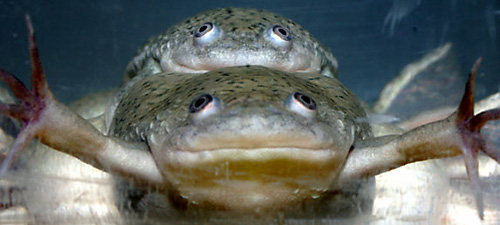Please note: Osher Rainforest will be closed for maintenance Jan. 14–16.
Science News
Frogicide
March 4, 2010

Tyrone Hayes has been working with frogs and the pesticide atrazine for a long time. He knows what it does to male frogs and now he can prove it.
Some 80 million pounds of the herbicide atrazine are applied annually on U.S. farms to control weeds and increase crop yield, but such widespread use also makes atrazine the most common pesticide contaminant of ground and surface water, according to various studies.
Since 2002, Hayes has known that tadpoles raised in atrazine-contaminated water become hermaphrodites. His recent study goes even farther: atrazine also wreaks havoc with the sex lives of adult male frogs, emasculating three-quarters of them and turning one in ten into females.
This had been difficult to prove because male and female frogs are difficult to tell apart. And even under a microscope, frog chromosomes appear the same.
To overcome such challenges, Hayes’s colleague Roger Liu developed a line of all-male frogs so that the genetics would be unequivocal. At the same time, in 2008, another lab discovered a sex-linked genetic marker, making it easier to distinguish between males and females.
The 75% of male frogs that are emasculated can simply not reproduce, while the 10% that become females can mate, but their offspring are entirely male. Another 10% are not affected by atrazine at all. Hayes and his colleagues published their findings earlier this week in the journal Proceedings of the National Academy of Sciences.
Other recent studies have also found a possible link between human birth defects and low birth weight due to atrazine exposure in the womb. While atrazine is already banned in Europe, the Environmental Protection Agency is still reviewing its regulations on use of the pesticide.
As amphibian populations decline worldwide for a variety of reasons, let’s hope that atrazine can eventually cease to be a threat.